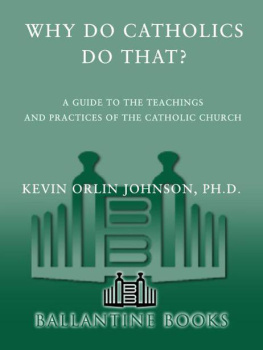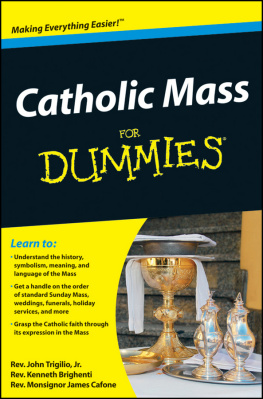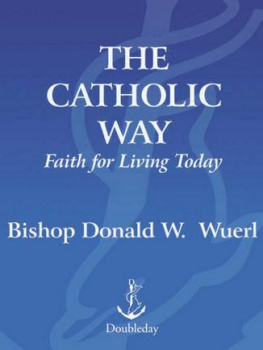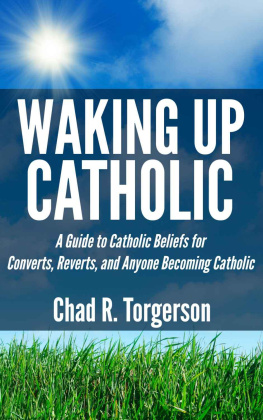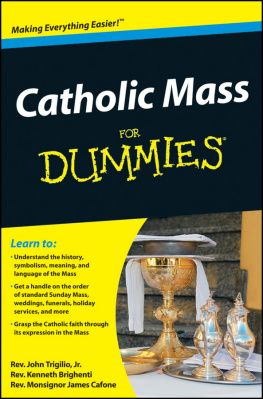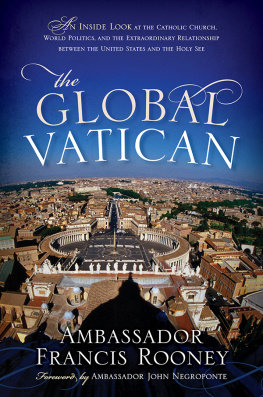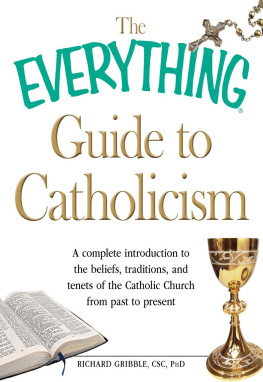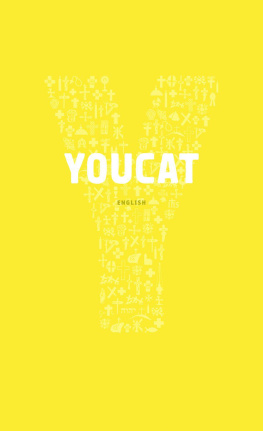


Nihil Obstat
Rev. Robert A. Coerver
Censor LibrorumImprimatur
Most Reverend Charles Grahmann, D.D.
Bishop of DallasA Ballantine Book
Published by The Random House Publishing GroupCopyright 1994 by Kevin Orlin JohnsonAll rights reserved.Published in the United States by Ballantine Books, an imprint of The Random House Publishing Group, a division of Random House, Inc., New York, and simultaneously in Canada by Random House of Canada Limited, Toronto. Originally published by Ballantine Books under the title Expressions of the Catholic Faith in 1994.Ballantine and colophon are registered trademarks of Random House, Inc.Grateful acknowledgment is made to the following for permission to reprint previously published material:
The Liturgical Press: Excerpts from The Faith of Early Fathers by William A. Jurgens, 1970. Reprinted with permission of The Liturgical Press, Collegeville, Minnesota 56321.
Ashley Montagu: Excerpt from The Humanization of Man by Ashley Montagu, World Publishing, 1964. Used by permission of the author.
Vice-Postulao de Francisco e Jacinta Marto, Ftima, Portugal: Excerpt from Sr. Lucas memoirs, Ftima In Lucas Own Words .Quotations from the Bible follow the New American Catholic Edition of the Holy Bible , Confraternity version, Benziger Brothers, New York, 1961.www.ballantinebooks.comLibrary of Congress Catalog Card Number: 95-94537eISBN: 978-0-307-80344-3v3.1
DOMTo
Stanley Cisler, Sr .
Best Teacher, Best Friend
THANKS
to all of the people who helped in the preparation of this book, particularly Rev. Dennis Klemash, O.F.M. Cap., Assistant Pastor, Shrine of the Sacred Heart, Washington, D.C.; James D. and Frances Lancaster, Dallas, Texas; Rev. Andrew Ciferni, O. Praem., Washington Theological Union; Rev. Robert Coerver, Censor Librorum of the Diocese of Dallas; Dr. James A. Coriden, Washington Theological Union; Henry Dunow, Harold Ober Associates; Craig DOoge, Library of Congress; Richard Gannon , Gannons Gift Shop, Parma, Ohio; Debbie Landrigan, former editor of The Texas Catholic , in which some of this material appeared for the first time; Rev. Msgr. William Lori, Secretary to His Eminence the Cardinal Archbishop of Washington; Rev. Joseph Mindling, O.F.M. Cap.; Lyle Novinski, Chair, Department of Art, University of Dallas; Rev. Msgr. W. Louis Quinn, Cathedral of St. Matthew, Washington, D.C.; Rev. Charles F. Shelby, C.M., Association of the Miraculous Medal; Mary South; Rev. Peter M. J. Stravinskas, Editor, The Catholic Answer; and Michael Nikonchuk, F.S.C. (ret. ).

CONTENTS
PREFACE

SUBSTANCE AND IMAGE
How to Tell Religion from Culture
I F YOU GO TO ANY of the Churchs great metropolitan shrines here in the United Statesor anywhere else in the worldyoull probably see the Mass celebrated in a fairly spectacular setting. You might hear sumptuous music while gorgeous vestments and clouds of incense move against a background of paintings, sculptures, mosaics, stained glass, and walls and floors of colored marble: impressive testimony to the Churchs great and ancient patronage of Christian art.
But you might also go to a Mass where theres no incense, no marble, no pictorial art of any kind. If you go to a church staffed by members of the Cistercian order, for instance, or the Franciscan, you might see only the most modest setting and the simplest possible vestments. Neither of these great orders believes in putting a lot of visual art into their churches. St. Francis of Assisi, for instance, who founded the Franciscan order, noted that they were satisfied to remain in poor and deserted little churches, and he forbade his followers to build or accept as gifts any churches not according to that holy poverty we have promised. The 1536 Constitution of the strict branch of his order, the Capuchins, added that they should be careful not to allow any costliness, rarity, or superfluity to appear in the things pertaining to divine worship.
Its a perfectly legitimate point of view; and, like many others in the Church, the Franciscans therefore build perfectly plain buildings for themselves and concentrate their creative energies on other occupations, like missionary work here and abroad. In fact, its not that hard to find a Mass so austere that the casual observer might guess that its a service in a Protestant church.
But it isnt. Its the same Mass, either way. You can rest assured that the words are the same, the sacrament is the same, and the priests both received their priesthood through exactly the same ceremony, from a bishop whos the direct successor of the Apostles.
So the substance of the faith is the same either way, even though the expression of that faith is different. In America today, a lot of people who seek Christ seem to be kept away from the Church on the basis of externals alone; much of the Churchs liturgythe Churchs public ceremonial acts of worshipher art, and her practices must appear uncomfortably foreign to them. But, if you talk with them about religion, sometimes youd think that they wouldnt disagree on any basic tenet of the Faith at all.
Maybe the difficulty is that style is so important to many Protestant sects. After all, a lot of Protestant denominations separated from the Church, or from previously separated sects, on precisely the grounds of external expression. Thats understandable. Whenever people are confronted with foreign styles and foreign customs, it can split the world into an us-and-them situation that keeps people from ever getting to the really important part: religion itself.
In fact, your reaction to a style of worship doesnt seem to depend on what religion you hold as much as it depends on where you came from. Most Catholics in this country came here from Italy, Ireland, France, Spain, southern Germany, and Latin America. These places were all shaped by cultures that customarily express their highest and best thought visually; they paint and sculpt and build what they feel most strongly. Most Protestants, on the other hand, came here from England, northern Germany, and Scandinavia; these cultures customarily express their highest thoughts in words and in music. Its the culture of Michelangelo versus the culture of Bach.
Theyve never seen eye to eye, but they owe a great deal to each other. When the Church entered northern Europe after the fall of Rome, her missionaries fostered a great flowering of native literary and musical forms that brought those arts to the notice of the whole world. For one thing, they showed people how to write things down. The first written Scots text, the first written English and German texts, are all Church documents; in fact, it was early missionaries to Bulgaria who invented the Slavonic alphabet so that the literature of that language could be preserved and turned to good use. Even the Irish didnt have an alphabet before Patrick. And the missionary monks worked out musical notation, too, so the native songs of ancient Ireland and the Frankish kingdoms have echoed through the ages in the Churchs liturgies all around the world.
Next page

